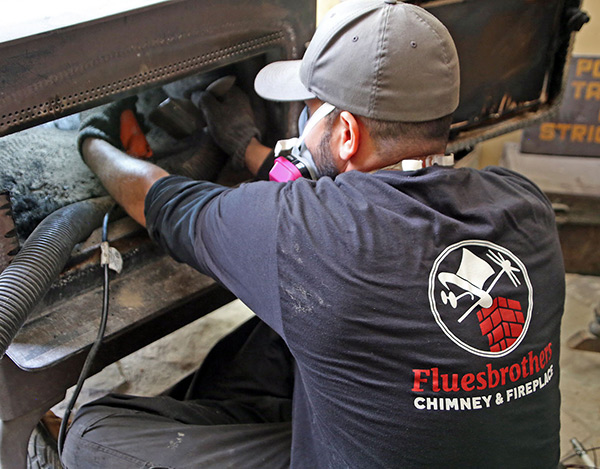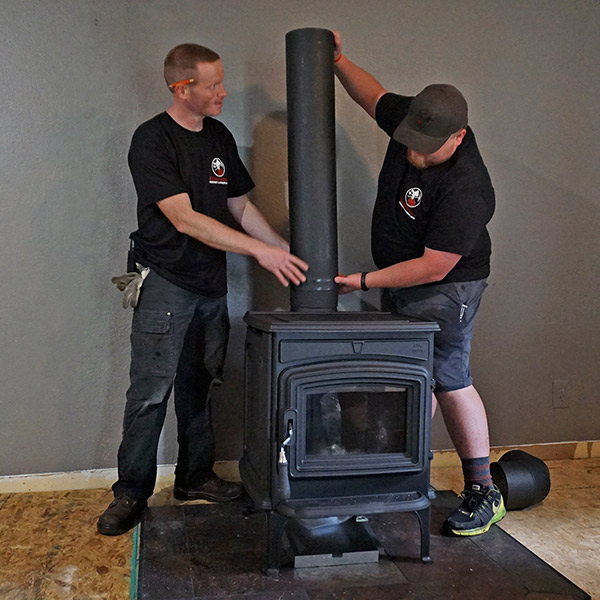Effects of a Leaky Chimney
Your chimney and fireplace are designed to withstand the test of time if properly maintained and looked after. One of the most notorious variables in determining your chimney and fireplace’s longevity is its level of moisture resistance. A chimney with poor moisture resistance can mean costly repairs to your chimney and your home, time without your fire, and even the need for a complete rebuild!
Water Intrusion & Your Chimney
Whether you have a Pre-Fab or Masonry unit, your chimney is constructed of many materials, all of which are adversely affected by moisture. This means that if water penetrates your chimney’s exterior, it can destroy it from the inside out. A leaky chimney can result in:
- Rusted chimney and fireplace components (damper, chimney flue, utility flue, gas line/valves)
- Deteriorated metal or masonry firebox assemblies
- Rotting internal or nearby wood framing
- Water stained walls and ceiling
- Stained chimney exterior
- Decayed interior and exterior mortar
- Cracked or deteriorated flue lining system
- Collapsed hearth support
- Tilted or collapsed chimney structure
- Compromised chimney stability
A leaky chimney, if not repaired in a timely fashion, can cause immense damage to other areas of your home as well. Beyond the costly repairs that a leaky chimney can create, it can also create breathing/respiratory issues for family members; both with and without a history of respiratory problems. Once the moisture has made its way in, and warmer months set in, your home is now susceptible to mold/mildew/unwanted growth.
What You Should Do
Listen for the sounds of running water near your fireplace and chimney during heavier rains. Conduct your own visual inspection around the exterior of your chimney, from the ground, and take note if you notice any sort of discoloration or growth. If you hear or see evidence of water intrusion, call our office today so we can schedule your chimney and fireplace inspection!
What Southern Chimneys Will Do
Southern Chimneys will come out and conduct a full, 18-point inspection on your entire fireplace and chimney system. We will trace the water intrusion and we will get the issue resolved! We work alongside a team of skilled roofers and siding contractors, so in the chance that your water intrusion isn’t directly linked to the chimney, we will get you in contact with one of our partners!
This post first appeared on https://southernchimneys.com


 The combustion of wood produces several natural by-products, including soot, ash, and creosote, to name a few. Creosote starts as a powdery substance but will turn into a thick, crusty, and highly flammable material that is extremely difficult to remove if allowed to accumulate. And if the wood stove is not regularly cleaned, the inside of your
The combustion of wood produces several natural by-products, including soot, ash, and creosote, to name a few. Creosote starts as a powdery substance but will turn into a thick, crusty, and highly flammable material that is extremely difficult to remove if allowed to accumulate. And if the wood stove is not regularly cleaned, the inside of your  Smokey fires
Smokey fires Spa-like design has been trending for a while, making master bathrooms more beautiful than ever. A fireplace in the bathroom can provide an extra “wow factor” that makes your home feel like a veritable resort. Also, if you add a fireplace in your master bathroom, it would make you a design trendsetter! Even though a bathroom fireplace is a desirable feature among the majority of homebuyers surveyed, recent research revealed that only about 10% of all master bathrooms include a fireplace. This is an idea whose time has come.
Spa-like design has been trending for a while, making master bathrooms more beautiful than ever. A fireplace in the bathroom can provide an extra “wow factor” that makes your home feel like a veritable resort. Also, if you add a fireplace in your master bathroom, it would make you a design trendsetter! Even though a bathroom fireplace is a desirable feature among the majority of homebuyers surveyed, recent research revealed that only about 10% of all master bathrooms include a fireplace. This is an idea whose time has come. Zone heating, as referred to above, makes the best sense when everyone’s bedroom is equipped with a fireplace. Bedrooms can be enjoyed more than ever as individualized personal sanctuaries when there’s a fireplace to keep you warm and provide an ambiance that feeds the soul. There’s something about a mesmerizing fire that makes it an old-world luxury anywhere, anytime.
Zone heating, as referred to above, makes the best sense when everyone’s bedroom is equipped with a fireplace. Bedrooms can be enjoyed more than ever as individualized personal sanctuaries when there’s a fireplace to keep you warm and provide an ambiance that feeds the soul. There’s something about a mesmerizing fire that makes it an old-world luxury anywhere, anytime.
 The majority of homeowners who look into purchasing a fireplace blower are those using open masonry fireplaces. This style of fireplace is beautiful to look at and brings lots of ambiance to a room, but it’s not known as a producer of high heat. There’s plenty of heat in the firebox, but usually 80% or more of it channels right up the chimney and is lost forever.
The majority of homeowners who look into purchasing a fireplace blower are those using open masonry fireplaces. This style of fireplace is beautiful to look at and brings lots of ambiance to a room, but it’s not known as a producer of high heat. There’s plenty of heat in the firebox, but usually 80% or more of it channels right up the chimney and is lost forever. Fireplace insert: These are heavy-duty appliances that come from a factory ready to install in the firebox of your masonry fireplace. Inserts produce and retain upwards of 80% of the heat they create, meaning a lot more heat for your home.
Fireplace insert: These are heavy-duty appliances that come from a factory ready to install in the firebox of your masonry fireplace. Inserts produce and retain upwards of 80% of the heat they create, meaning a lot more heat for your home.

 AIR / OXYGEN
AIR / OXYGEN HEAT
HEAT What Makes Smoke Go Up the Chimney?
What Makes Smoke Go Up the Chimney? Chimney Obstructions
Chimney Obstructions With countless old and historic homes throughout Boston, many homeowners have visions of getting cozy around the fireplace in the winter. However, the reality might be a lot different if your fireplace is unused for many years.
With countless old and historic homes throughout Boston, many homeowners have visions of getting cozy around the fireplace in the winter. However, the reality might be a lot different if your fireplace is unused for many years.